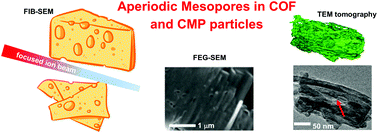Three dimensional nanoscale analysis reveals aperiodic mesopores in a covalent organic framework and conjugated microporous polymer†
Abstract
The integrated analytical approach developed in this study offers a powerful methodology for the structural characterisation of complex molecular nanomaterials. Structures of a covalent organic framework based on boronate esters (COF-5) and a conjugated microporous polymer (Aza-CMP) have been investigated by a combination of several electron microscopy techniques elucidating the three-dimensional topology of the complex polycrystalline (COF) and non-crystalline (CMP) materials. Unexpected, aperiodic mesoporous channels of 20–50 nm in diameter were found to be penetrating the COF and CMP particles, which cannot be detected by X-ray diffraction techniques. The mesopores appear to be stable under a range of different conditions and accessible to gas molecules, exhibiting a particular bonding capability with CO2 in the case of the CMP. The mesoporosity is unrelated to the intrinsic chemical structures of the COF or CMP but rather it reflects the mechanisms of polymer particle formation in a polycondensation reaction. The mesopores may be templated by clusters of solvent molecules during the COF or CMP synthesis, leaving cavities within the polymer particles. The unexpected mesoporosity discovered in COF and CMP materials begs for re-assessment of the nature of framework materials and may open new opportunities for applications of these molecular materials in gas sorption or catalysis.



 Please wait while we load your content...
Please wait while we load your content...